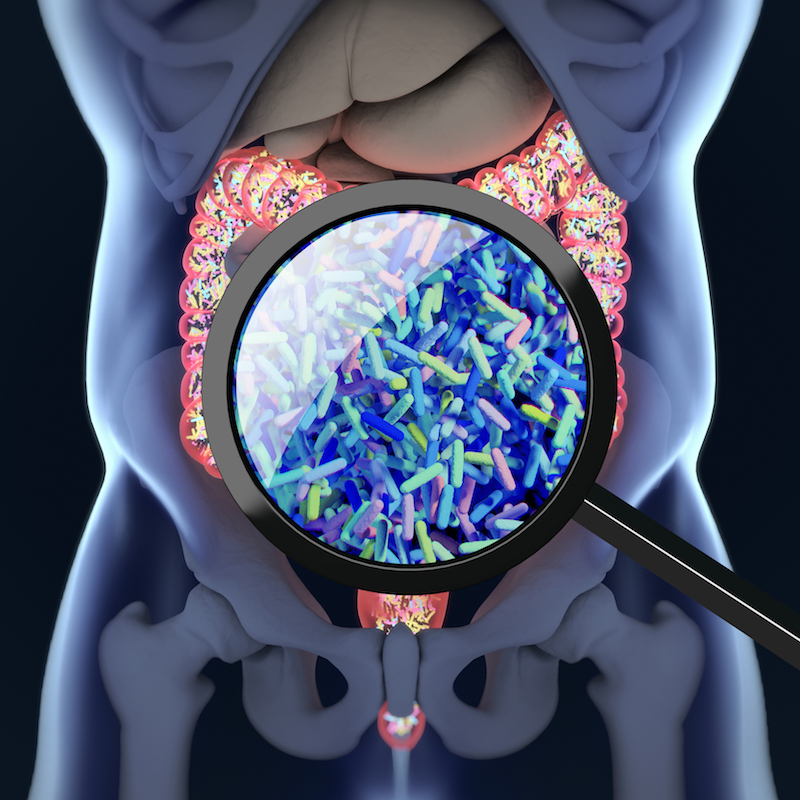Microbiome and Nutrition
The complex community of bacteria, yeasts and viruses living in our intestines, collectively known as the gut microbiome, is shaped, in part, by what we eat. Genetics, environment, and other factors also influence an individual’s microbial community. Research at the NRI investigates these complex relationships and their impact on disease risk. We use animal models and bioinformatics to study the associations between nutritional metabolites, gut microbiome, and health. What happens in the gut doesn’t stay in the gut. Your microbiome can play a role in cardiovascular disease, obesity and diabetes, and even cancer. Our team envisions a future where analysis of your microbiome can determine disease risk, and medical foods can be prescribed to treat and prevent disease by regulating the microbiome.
Publications
Microbiome and Nutrition Publications
2020
Population studies of TMAO and its precursors may help elucidate mechanisms. Meyer K
2019
Association of dietary patterns with the gut microbiota in older, community-dwelling men. Meyer K
2018
Meta-analysis of human genome-microbiome association studies: the MiBioGen consortium initiative. Meyer K
Human microbiota, blood group antigens, and disease. Sumner S
2017
Trimethylamine N-Oxide, the Microbiome, and Heart and Kidney Disease. Zeisel S
2016
Diet and Gut Microbial Function in Metabolic and Cardiovascular Disease Risk. Meyer K
Antibiotic-mediated gut microbiome perturbation accelerates development of type 1 diabetes in mice. Sumner S
Related News
Liver Cancer Report Reveals New Links: Coffee is Protective, Obesity Increases Risk
April 1, 2015 • For the first time, a report from an ongoing systematic review of global research finds that drinking coffee lowers risk for liver cancer, a disease that is increasing in the U.S. and the second leading cause of cancer deaths worldwide.
Today’s report also finds strong evidence linking body fatness to increased risk for liver cancer. This means that liver cancer now officially joins the growing list of cancers caused by overweight and obesity. Sixty-nine percent of U.S. adults are currently overweight or obese, according to the Centers for Disease Control and Prevention.
The Folic Acid Dilemma
April 1, 2015 • In 1996, the Food and Drug Administration (FDA) made it mandatory to add folic acid (FA) to grain products used to make cereal, bread, pasta and other foods. The ruling, which was intended to prevent neural tube defects (NTDs) – see Sidebar – has been very successful: The incidence of NTDs fell 36% over the following decade.
The FDA’s ruling was unique because the target population (women of child-bearing age) is much smaller than the population affected (anyone eating fortified foods), especially now that so many countries around the world add FA to wheat, corn, and rice. Luckily, studies around the globe prove that FA benefits the general population by lowering the incidence of heart disease, stroke, and even mood disorders…which is why FA is also present in multivitamin supplements.
Pinpointing Individual Susceptibility for Heart Disease
March 31, 2015 • The following has been reprinted from NC Research Campus, transforming-science.com
Eat a healthy and balanced diet. That is the first advice that people who need to reduce their risk for cardiovascular disease (CVD) receive. But what if some nutrients in “healthy” foods interact with an individual’s genetic make-up in a way that actually increases their risk for CVD.
That is the question that Brian Bennett, PhD, is trying to answer. Bennett is an assistant professor of genetics, nutrition and heart disease with the UNC Chapel Hill Nutrition Research Institute (NRI) at the NC Research Campus in Kannapolis. He is pushing the boundaries of nutrigenomics, which is the study of how genes and diet interact, to reveal new clues about individual susceptibility for atherosclerosis and other forms of CVD.
April 2015
April 22 • April 2015’s edition of SoundBites features: The Folic Acid Dilemma, Appetite for Life Lecture, Liver Cancer Report Reveals New Links, Training Your Doctor in Nutrition, and 2015 ISNN Congress.
2015 ISNN Congress
March 30, 2015 • The International Society of Nutrigenetics and Nutrigenomics (ISNN) will hold its 9th Congress May 17-19 on the campus of UNC Chapel Hill. This event convenes several hundred nutrition researchers, clinicians, dietitians and other healthcare providers who are leaders in the development and practice of advanced nutrition solutions. Keynote speakers are 2007 Nobel laureate Dr. Oliver Smithies (UNC Chapel Hill) and Dr. Bruce Ames (Children’s Hospital Oakland Research Institute and UC Berkeley), who will deliver an Appetite for Life lecture in Kannapolis May 20, 2015.
Local Research Institute Boosts Economy through Critical Nutrition Discoveries
March 17, 2015 • Eleven faculty research scientists at the UNC Nutrition Research Institute (NRI) in Kannapolis currently have externally funded grants to support their work exploring individualized nutrition. These awards are significant not only for providing the means by which the NRI can advance its scientific discoveries but also for their economic impact in the Charlotte region.


